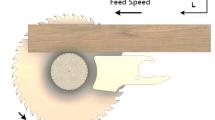Fagus
silvatica) and spruce (Picea excelsa). The machining process was carried out on a shaper with specific devices. The concerned variables were: cutting depth, feed rate and cutting speed. The mean chip thickness and cutting width were constant. The machining process was done in two different ways: conventional and climb cutting; thus it was possible to compare both working directions with the same machining parameters and watch their influence on the cutting forces, the power consumption and the surface roughness. The most important variables on the cutting forces are depth of cut, wood density and feed direction. With regard to power consumption, it was detected that the most important variables were cutting speed, feed direction, depth of cut and wood density. It was further demonstrated that the measured and calculated power have a very good correlation, and that the cutting forces can be determined by the calculated power. Thus, if cutting power is measured for a specific condition of wood and machine, the cutting forces can be estimated. The surface roughness was very homogeneous in all the tests. The better machining process was obtained when applying conventional cutting. Then the cutting forces, the power requirements and the roughness standard deviation reach smaller values.
Fagus silvatica
) und Fichtenholz (Picea excelsa). Der Bearbeitungsprozess erfolgte auf einer speziellen Holzhobelmaschine. Die relevanten Variabeln waren: die Schnitttiefe, der Vorschub und die Schnittgeschwindigkeit. Die mittlere Spanstärke und die Schnittbreite waren konstant. Die Bearbeitung wurde auf zwei verschiedene Arten durchgeführt: im Gleichlauf und im Gegenlauf, somit war es möglich, beide Bearbeitungsrichtungen unter Beibehaltung der Parameter zu vergleichen und ihren Einfluss auf die Schnittkräfte, den Leistungsbedarf und die Oberflächenrauhigkeit zu prüfen. Die wichtigsten Einflußvariabeln bezüglich der Schnittkräfte waren die Schnitttiefe, die Materialdichte und die Vorschubrichtung. Den Leistungsbedarf betreffend kamen wir zu dem Ergebnis, daß sowohl die Vorschubrichtung, die Materialdichte als auch die Schnittkräfte, -geschwindigkeit und -tiefe die Haupteinflußfaktoren waren. Es konnte gezeigt werden, daß die gemessene und berechnete Leistung gut korreliert sind, und daß die Schnittkräfte mittels der berechneten Leistung bestimmbar sind. Es ist daher möglich, durch Messen des Leistungsbedarfs einer Bearbeitung einer bestimmten Holzart auf einer definierten Maschine die Schnittkräfte abzuschätzen. Die Oberflächengüte war gleichbleibend in allen durchgeführten Versuchen. Die besten Versuchsergebnisse wurden in Gegenlaufbearbeitung erzielt. Die Schnittkräfte, der Leistungsbedarf und die Standardabweichung der Oberflächenrauhigkeit erreichen hier jeweils ihre Minimalwerte.
Similar content being viewed by others
Author information
Authors and Affiliations
Rights and permissions
About this article
Cite this article
Aguilera, A., Martin, P. Machining qualification of solid wood of Fagus silvatica L. and Piceaexcelsa L.: cutting forces, power requirements and surface roughness. Holz als Roh- und Werkstoff 59, 483–488 (2001). https://doi.org/10.1007/s001070100243
Issue Date:
DOI: https://doi.org/10.1007/s001070100243




